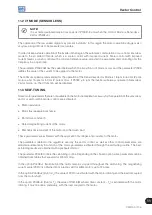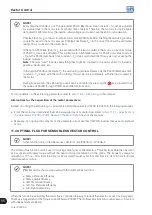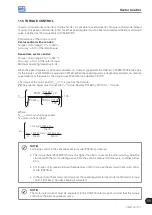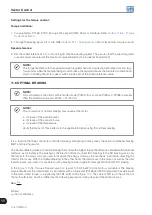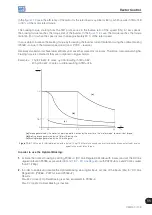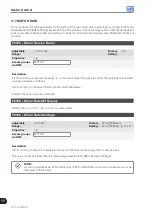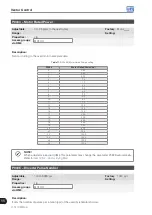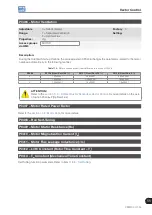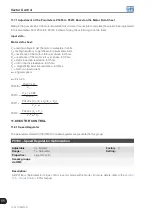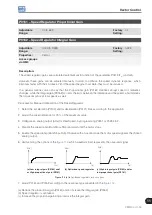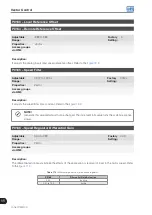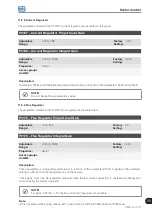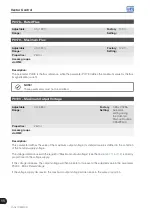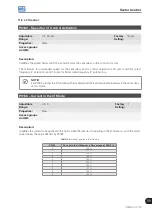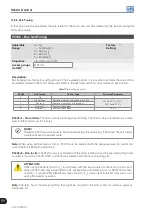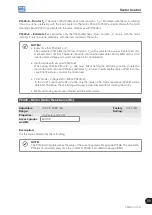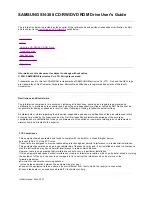
11
Vector Control
11-6 | CFW700
NOTE!
Every time that P0408=1 or 2 the parameter P0413 (Mechanic time constant – T
m
) will be adjusted
for a value close to the motor rotor mechanic time constant. Therefore, the motor rotor inertia (table
data valid for WEG motors), the inverter rated voltage and current, are taken into consideration.
P0408=2 (Run for I
m
) in the vector with encoder mode (P0202=5): After finishing the self-tuning routine,
couple the load to the motor and set P0408=4 (Estimate T
m
). In this case P0413 will be estimated
taking into account also the driven load.
If the option P0408=2 (Run for I
m
) is executed with the load coupled to the motor, an incorrect value
of P0410 (I
m
) may be estimated. This will implicate in estimation error for P0412 (rotor time constant
- T
r
) and for P0413 (mechanic time constant – T
m
). Overcurrent fault (F071) may also occur during the
inverter operation.
Note
: The term “load” includes everything that might be coupled to the motor shaft, for instance,
gearbox, inertia disk, etc.
In the option P0408=4 (Estimate T
m
) the self-tuning routine estimates only the P0413 (Mechanic time
constant – T
m
) value, with the motor rotating. It must be done, preferably, with the load coupled to
the motor.
During its execution, the self-tuning routine can be canceled by pressing the
key, provided that
the values of P0409 through P0413 be all different from zero.
For more details on the self-tuning parameters, refer to
, in this manual.
Alternatives for the acquisition of the motor parameters:
Instead of running the self-tuning, it is possible to obtain the values for P0409 to P0412 in the following manner:
From the motor test data sheet that can be supplied by its manufacturer. Refer to
the Parameters P0409 to P0412 Based on the Motor Data Sheet
, of this manual.
Manually, by copying the contents of the parameters from another CFW700 inverter that uses an identical
motor.
11.4 OPTIMAL FLUX FOR SENSORLESS VECTOR CONTROL
NOTE!
Active function only on the Sensorless Vector mode (P0202=4), if P0406=2.
The Optimal Flux function can be used for driving some types of WEG motors
(*)
making it possible the operation
at low speed with rated torque without the need of forced ventilation on the motor. The frequency range for
operation is 12:1, i.e., from 5 Hz to 60 Hz for 60 Hz rated frequency motors and from 4.2 Hz to 50 Hz for 50 Hz
rated frequency motors.
NOTE!
(*)
WEG motors that can be used with the Optimal Flux function:
Nema Premium Efficiency.
Nema High Efficiency.
IEC Premium Efficiency.
IEC Top Premium Efficiency.
Alto Rendimento Plus.
When this function is activating, the motor flux is controlled in a way to reduce their electric losses on slow speeds.
That flux is dependent of the torque current filtered (P0009). The Optimal Flux function is unnecessary in motors
with independent ventilation.
Summary of Contents for CFW700
Page 2: ......
Page 4: ......
Page 8: ...Summary...
Page 34: ...2 General Information 2 4 CFW700...
Page 38: ...3 About the CFW700 3 4 CFW700...
Page 56: ...7 Starting up and Settings 7 4 CFW700...
Page 58: ...8 Available Control Types 8 2 CFW700...
Page 78: ...10 VVW Control 10 8 CFW700...
Page 158: ...13 Digital and Analog Inputs and Outputs 13 28 CFW700...














